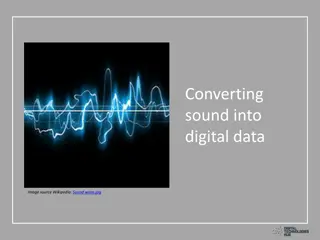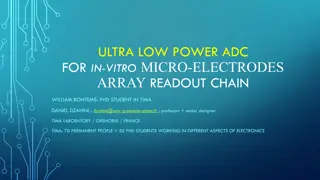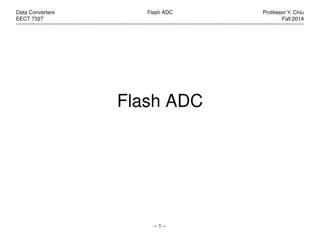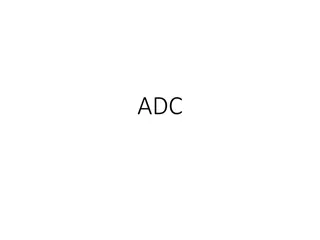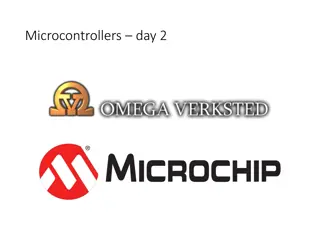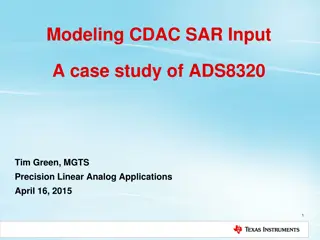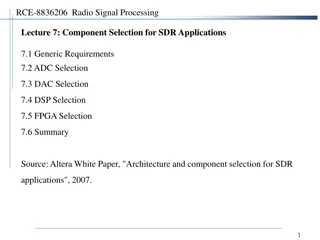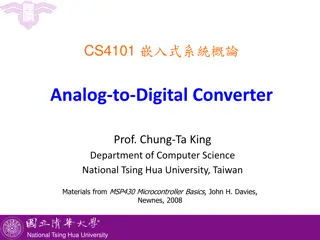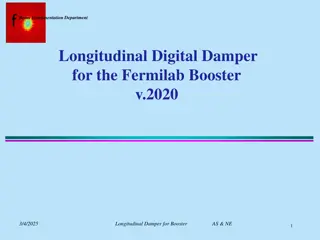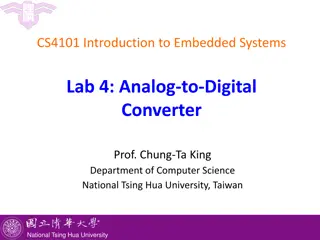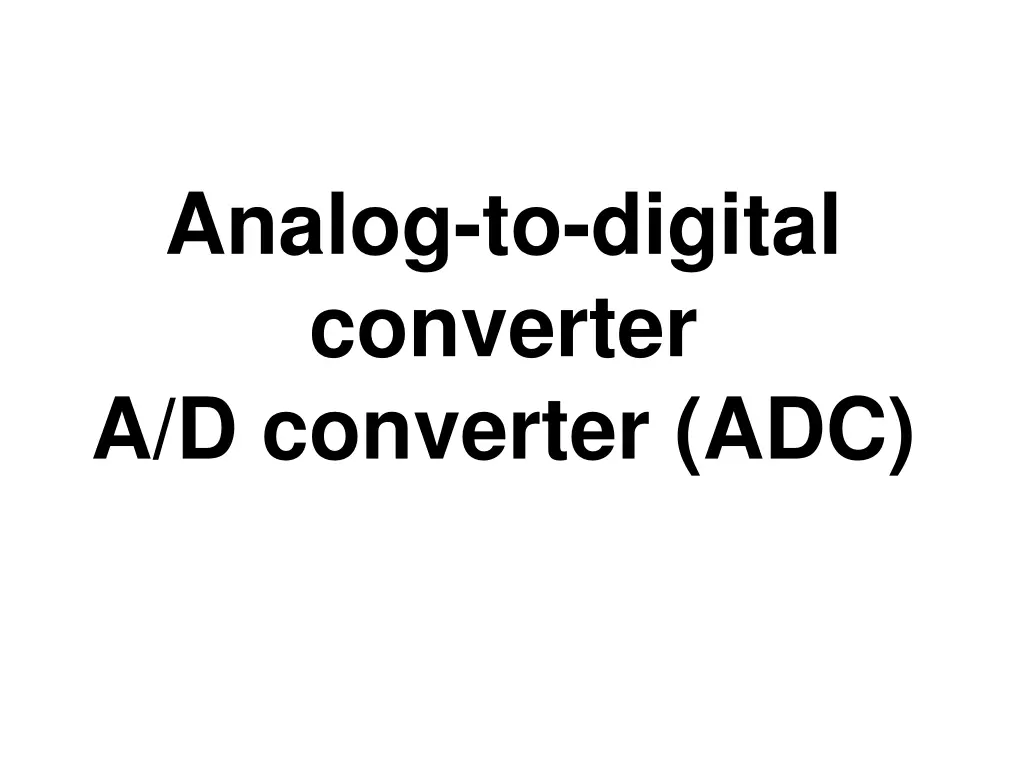
Understanding Analog-to-Digital Conversion in Microcontrollers
Learn how microcontrollers utilize Analog-to-Digital Converters (ADC) to process real-world analog signals such as temperature, pressure, and humidity in a digital format. Discover the principles, parameters, and types of ADCs used for signal reception and processing in modern electronics.
Download Presentation

Please find below an Image/Link to download the presentation.
The content on the website is provided AS IS for your information and personal use only. It may not be sold, licensed, or shared on other websites without obtaining consent from the author. If you encounter any issues during the download, it is possible that the publisher has removed the file from their server.
You are allowed to download the files provided on this website for personal or commercial use, subject to the condition that they are used lawfully. All files are the property of their respective owners.
The content on the website is provided AS IS for your information and personal use only. It may not be sold, licensed, or shared on other websites without obtaining consent from the author.
E N D
Presentation Transcript
Analog-to-digital converter A/D converter (ADC)
Analog-to-digital converter Microcontrollers can handle only digital data (0 and 1). Most of the real world signals are analog (sensors): temperature, pressure, humidity. For processing analog microcontroller first have to convert them into digital signals. That s where the ADC comes into picture. signals, the
Conversion example Analog signal is continuous both in time and in amplitude. By discretization both time and amplitude digital signal is obtained.
Signal reception In general, signal (data) reception is done in 3 steps: 1. Based on a physical quantity, the sensor provides an analog electrical value on its output. 2. For easy processing, the analog signal is converted into digital using the ADC. 3. The digital signal is transferred to the microcontroller for further processing.
Analog inputs Modern analog to digital converters, it is not necessary to use external circuits. microcontrollers have built-in
ADC parameters Principle: successive approximation 6 channels (multiplexed), 10-bit resolution (result in range 0-1023)
Analog-to-digital conversion Reference voltage 5V, all analog voltages are converted into equivalent digital value. The input range (0V-5V) is divided into 210 = 1024 steps. 0V in the input is converted into 0, 5V on the input is converted into 1023, and 2,5V on the input is converted into 512.
ADC types Successive approximation Flash converter (very high speed, lower resolution, many comparators are needed. For 8-bit converter 256 comparators are needed. Other terminology: ADC pre-scaler, ADC registers.
ADC pre-scaler The ADC converts the analog signal into a digital signal in periodic time intervals. This interval is determined by the frequency of the oscillator. The ADC works on frequencies between 50kHz and 200kHz. The CPU clock is much higher, so division must be done. THe ADC frequency is obtained by dividing the CPU frequency with the pre-scaler.
ADC pre-scaler There are pre-defined division fators: 2, 4, 8, 16, 32, 64 i 128. For example, pre-scaler 64 means F_ADC = F_CPU/64 F_CPU = 16MHz, F_ADC = 16M/64 = 250kHz How to choose the frequency?
ADC pre-scaler There is a trade-off between frequency and precision. Higher frequency will result in lower precision and vice-versa.
ADC registers ADMUX ADC Multiplexer Selection Register Bits 7-6 : Selection of reference voltage
Reference voltage The ADC needs reference voltage that is determined through AREF, AVCC and GND. The VCC can vary!
ADC registers ADLAR ADC left adjust result 1 : the result is left-justified Bits 4-0: Channel selection of the ADC ADCSRA ADC Control and Status Register A
ADCSRA Bit 7 ADEN ADC Enable As the name says, it enables the ADC feature. Unless this is enabled, ADC operations cannot take place across PORTA i.e. PORTA will behave as GPIO pins. Bit 6 ADSC ADC Start Conversion Write this to 1 before starting any conversion. This 1 is written as long as the conversion is in progress, after which it returns to zero. Normally it takes 13 ADC clock pulses for this operation. But when you call it for the first time, it takes 25 as it performs the initialization together with it. Bit 5 ADATE ADC Auto Trigger Enable Setting it to 1 enables auto-triggering of ADC. ADC is triggered automatically at every rising edge of clock pulse. View the SFIOR register for more details.
ADCSRA Bit 4 ADIF ADC Interrupt Flag Whenever a conversion is finished and the registers are updated, this bit is set to 1 automatically. Thus, this is used to check whether the conversion is complete or not. Bit 3 ADIE ADC Interrupt Enable When this bit is set to 1 , the ADC interrupt is enabled. This is used in the case of interrupt-driven ADC. Bits 2:0 ADPS2:0 ADC Prescaler Select Bits The prescaler (division factor between XTAL frequency and the ADC clock frequency) is determined by selecting the proper combination from the following.
ADCL i ADCH ADC data registers qw
ADC init void adc_init() { // AREF = AVcc ADMUX = (1<<REFS0); // ADC Enable and prescaler of 128 // 16000000/128 = 125000 ADCSRA = (1<<ADEN)|(1<<ADPS2)|(1<<ADPS1)|(1<<ADPS0); }
ADC read uint16_t adc_read(uint8_t ch) { // select the corresponding channel 0~7 // ANDing with 7 will always keep the value // of ch between 0 and 7 ch &= 0b00000111; // AND operation with 7 ADMUX = (ADMUX & 0xF8)|ch; // clears the bottom 3 bits before //ORing // start single convertion // write 1 to ADSC ADCSRA |= (1<<ADSC); // wait for conversion to complete // ADSC becomes 0 again // till then, run loop continuously while(ADCSRA & (1<<ADSC)); return (ADC); }

